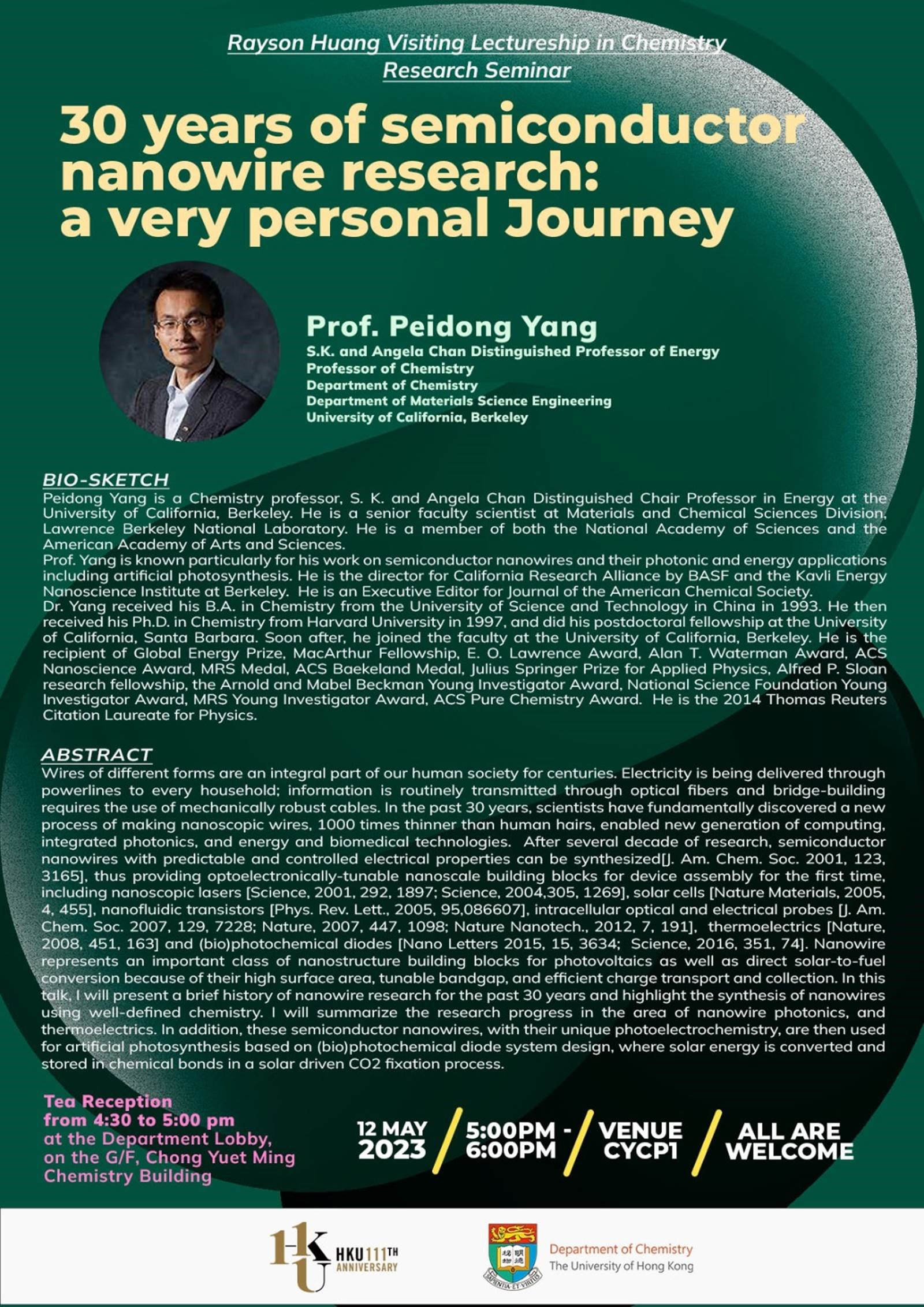| Date | 12 May 2023 |
| Time | 5:00 pm – 6:00 pm (HKT) |
| Venue | Lecture Theatre P1, Chong Yuet Ming Chemistry Building |
| Speaker | Prof. Peidong Yang |
| Institution | S.K. and Angela Chan Distinguished Professor of Energy Professor of Chemistry Department of Chemsitry Department of Materials Science Engineering University of California, Berkeley |

Title:
30 years of semiconductor nanowire research: a very personal Journey
Schedule:
Date: 12 May 2023 (Fri)
Time: 5:00 pm – 6:00 pm (HKT)
Venue:
Lecture Theatre P1, Chong Yuet Ming Chemistry Building
Speaker:
Prof. Peidong Yang
S.K. and Angela Chan Distinguished Professor of Energy
Professor of Chemistry
Department of Chemsitry
Department of Materials Science Engineering
University of California, Berkeley
Bio-sketch:
Peidong Yang is a Chemistry professor, S. K. and Angela Chan Distinguished Chair Professor in Energy at the University of California, Berkeley. He is a senior faculty scientist at Materials and Chemical Sciences Division, Lawrence Berkeley National Laboratory. He is a member of both the National Academy of Sciences and the American Academy of Arts and Sciences.
Prof. Yang is known particularly for his work on semiconductor nanowires and their photonic and energy applications including artificial photosynthesis. He is the director for California Research Alliance by BASF and the Kavli Energy Nanoscience Institute at Berkeley. He is an Executive Editor for Journal of the American Chemical Society.
Dr. Yang received his B.A. in Chemistry from the University of Science and Technology in China in 1993. He then received his Ph.D. in Chemistry from Harvard University in 1997, and did his postdoctoral fellowship at the University of California, Santa Barbara. Soon after, he joined the faculty at the University of California, Berkeley. He is the recipient of Global Energy Prize, MacArthur Fellowship, E. O. Lawrence Award, Alan T. Waterman Award, ACS Nanoscience Award, MRS Medal, ACS Baekeland Medal, Julius Springer Prize for Applied Physics, Alfred P. Sloan research fellowship, the Arnold and Mabel Beckman Young Investigator Award, National Science Foundation Young Investigator Award, MRS Young Investigator Award, ACS Pure Chemistry Award. He is the 2014 Thomas Reuters Citation Laureate for Physics.
Abstract:
Wires of different forms are an integral part of our human society for centuries. Electricity is being delivered through powerlines to every household; information is routinely transmitted through optical fibers and bridge-building requires the use of mechanically robust cables. In the past 30 years, scientists have fundamentally discovered a new process of making nanoscopic wires, 1000 times thinner than human hairs, enabled new generation of computing, integrated photonics, and energy and biomedical technologies. After several decade of research, semiconductor nanowires with predictable and controlled electrical properties can be synthesized[J. Am. Chem. Soc. 2001, 123, 3165], thus providing optoelectronically-tunable nanoscale building blocks for device assembly for the first time, including nanoscopic lasers [Science, 2001, 292, 1897; Science, 2004,305, 1269], solar cells [Nature Materials, 2005, 4, 455], nanofluidic transistors [Phys. Rev. Lett., 2005, 95,086607], intracellular optical and electrical probes [J. Am. Chem. Soc. 2007, 129, 7228; Nature, 2007, 447, 1098; Nature Nanotech., 2012, 7, 191], thermoelectrics [Nature, 2008, 451, 163] and (bio)photochemical diodes [Nano Letters 2015, 15, 3634; Science, 2016, 351, 74]. Nanowire represents an important class of nanostructure building blocks for photovoltaics as well as direct solar-to-fuel conversion because of their high surface area, tunable bandgap, and efficient charge transport and collection. In this talk, I will present a brief history of nanowire research for the past 30 years and highlight the synthesis of nanowires using well-defined chemistry. I will summarize the research progress in the area of nanowire photonics, and thermoelectrics. In addition, these semiconductor nanowires, with their unique photoelectrochemistry, are then used for artificial photosynthesis based on (bio)photochemical diode system design, where solar energy is converted and stored in chemical bonds in a solar driven CO2 fixation process.
Tea Reception from 4:30 pm to 5:00 pm at the Department Lobby, Ground Floor, Chong Yuet Ming Chemistry Building.
